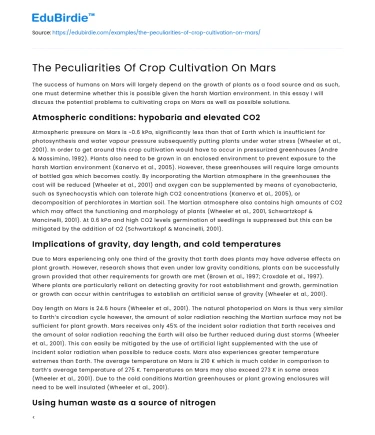The success of humans on Mars will largely depend on the growth of plants as a food source and as such, one must determine whether this is possible given the harsh Martian environment. In this essay I will discuss the potential problems to cultivating crops on Mars as well as possible solutions.
Atmospheric conditions: hypobaria and elevated CO2
Atmospheric pressure on Mars is ~0.6 kPa, significantly less than that of Earth which is insufficient for photosynthesis and water vapour pressure subsequently putting plants under water stress (Wheeler et al., 2001). In order to get around this crop cultivation would have to occur in pressurized greenhouses (Andre & Massimino, 1992). Plants also need to be grown in an enclosed environment to prevent exposure to the harsh Martian environment (Kanervo et al., 2005). However, these greenhouses will require large amounts of bottled gas which becomes costly. By incorporating the Martian atmosphere in the greenhouses the cost will be reduced (Wheeler et al., 2001) and oxygen can be supplemented by means of cyanobacteria, such as Synechocystis which can tolerate high CO2 concentrations (Kanervo et al., 2005), or decomposition of perchlorates in Martian soil. The Martian atmosphere also contains high amounts of CO2 which may affect the functioning and morphology of plants (Wheeler et al., 2001, Schwartzkopf & Mancinelli, 2001). At 0.6 kPa and high CO2 levels germination of seedlings is suppressed but this can be mitigated by the addition of O2 (Schwartzkopf & Mancinelli, 2001).
Implications of gravity, day length, and cold temperatures
Due to Mars experiencing only one third of the gravity that Earth does plants may have adverse effects on plant growth. However, research shows that even under low gravity conditions, plants can be successfully grown provided that other requirements for growth are met (Brown et al., 1997; Croxdale et al., 1997). Where plants are particularly reliant on detecting gravity for root establishment and growth, germination or growth can occur within centrifuges to establish an artificial sense of gravity (Wheeler et al., 2001).
Day length on Mars is 24.6 hours (Wheeler et al., 2001). The natural photoperiod on Mars is thus very similar to Earth’s circadian cycle however, the amount of solar radiation reaching the Martian surface may not be sufficient for plant growth. Mars receives only 45% of the incident solar radiation that Earth receives and the amount of solar radiation reaching the Earth will also be further reduced during dust storms (Wheeler et al., 2001). This can easily be mitigated by the use of artificial light supplemented with the use of incident solar radiation when possible to reduce costs. Mars also experiences greater temperature extremes than Earth. The average temperature on Mars is 210 K which is much colder in comparison to Earth’s average temperature of 275 K. Temperatures on Mars may also exceed 273 K in some areas (Wheeler et al., 2001). Due to the cold conditions Martian greenhouses or plant growing enclosures will need to be well insulated (Wheeler et al., 2001).
Using human waste as a source of nitrogen
Plants have been successful on Earth due to the characteristics of Earth soil. Martian soil contains sufficient quantities of the essential minerals to sustain plant life with the exception of reactive nitrogen such as NO3 and NH4 (Wamelink et al., 2014). This is due to the absence of organic matter on Mars which when mineralised forms reactive nitrogen (Stevens et al., 2011). This can be solved by use of nitrogen-fixing bacteria. The fixation of nitrogen by these bacteria requires atmospheric nitrogen which may pose another problem as Mars’ atmosphere is extremely thin and contains only trace amounts of nitrogen (Wamelink et al., 2014). Nitrogen can be obtained by the use of human waste to fertilise Martian soil. Organic faecal nitrogen (in the form of NO3) can be retained in compost while pathogens are eliminated by employing thermophilic composting (Wang & Wang, 2008; Bai & Wang, 2010). Composting at a high temperature range (50°C – 65°C) has been found to result in the loss of only 0.7% of organic faecal nitrogen (Bai & Wang, 2010). Nitrogen-fixing bacteria, which can be grown on Mars (Kral et al., 2004) can be used to convert nitrogen from faecal matter and urine into forms usable by plants.
Soil toxicity
Martian soils contain heavy metals such as aluminium and chromium as well as toxic concentrations of perchlorates (ClO4) which are known to impair thyroid function in humans. Perchlorates are very persistent and may occur in ground ice as well as soils and bio-accumulate in plant tissues (Ha et al., 2011), thus contaminating potential food and water resources on Mars (Davila et al., 2013). Removal of perchlorates from Martian soils can be done while producing oxygen which can then be used in Martian greenhouses to provide an atmosphere suitable for plant respiration (Musgrave et al., 1998) or alternatively for human respiration, by using micro-organisms that reduce perchlorates under anaerobic conditions. This method will also result in minimal alteration to the soil (Davila et al., 2013) thus maintaining its quality for crop cultivation.
Aside from the lack of reactive nitrogen and presence of toxic substances, Martian soil simulant has proven to sustain plant growth better than nutrient-poor Earth soil (Foy et al., 1978). Martian soil simulant containing organic matter has a greater water carrying capacity than earth as well as a lower pH which may promote a more stable nutrient balance (Wamelink et al., 2014).
Conclusion
Due to the capabilities of technology, the adverse surface conditions on Mars can be overcome to sustain crop growth. Crop cultivation will also be possible largely due to the potential of Martian soil to enhance plant growth. With further research and crop selection, crop cultivation on Mars may be feasible to support human colonies.






 Stuck on your essay?
Stuck on your essay?

